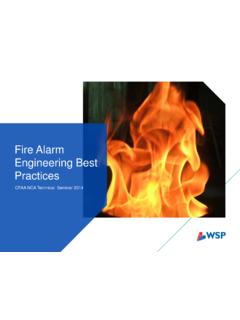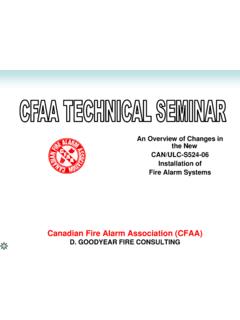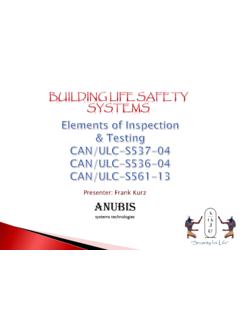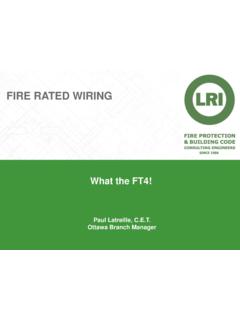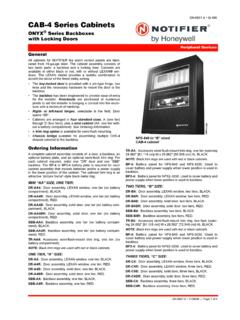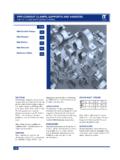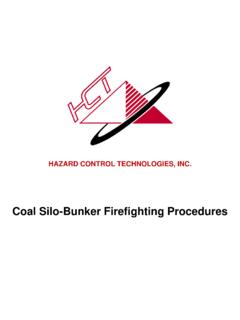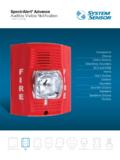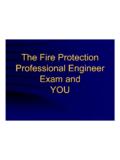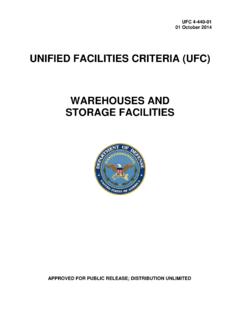Transcription of 2012 Ontario Building Code Changes Affecting Fire …
1 LRI 2010 2012 Ontario Building Code Changes Affecting fire Alarm Systems CFAA Annual Technical Seminar May 31, 2013 Ken Baird VP Systems LRI 2010 Developments in Life Safety Introduction Code Development Overview in Canada Who is responsible for Building Life Safety Building and fire Code Application Implication of fire and Life Safety Changes included in the 2012 Ontario Building Code (OBC) Additional CSA B-44 requirements for elevators Verification and testing of life safety systems 2 LRI 2010 MAINTAINING Building LIFE SAFETY WHO IS RESPONSIBLE? The Building owner is responsible for life safety of the occupants in their Building Typically the owner engages others to assist in meeting this obligation If the Building owner fails to ensure the requirements are met this can result in fines, a jail term or both Others who contract to provide services may also be held at fault, if they fail to carry out the services for which they contracted 3 LRI 2010 CODES Building Codes Applicable to new construction fire Codes Applicable to operation and maintenance National Building Code (NBC) model code A model set of technical requirements designed to provide an acceptable level of fire and life safety within a community.
2 Forms the base of all Provincial Building Codes Permits adoption by an appropriate authority Constitution Act Regulation in Canada identifying provincial and territorial governments as responsible for Building and fire safety 4 LRI 2010 Building CODES Building Code Application New buildings Existing buildings Reconstruction, renovation, alteration Extension/addition Changes in occupancy 5 LRI 2010 2012 Ontario Building CODE Legislation enabling the 2012 Ontario Building Code was passed in 2012 The 2012 Ontario Building Code will not come into force until January 1, 2014 The new OBC can be viewed on the Government of Ontario website, no published version is currently available Based upon the 2010 National Building Code Sections relating to fire alarm appear identical 6 LRI 2010 fire CODES fire Code Application Existing Buildings fire prevention fire fighting and life safety in buildings Uses, activities, hazards, limitations Service and Maintenance Emergency plans (reviewed annually and updated as needed)
3 A revised fire Code is complete No date has been set for its release 7 LRI 2010 REFERENCED STANDARDS Codes and Standards Regularly reviewed and revised by balanced committees based on geography, technical expertise and industry focus Standards are referenced by date of issue in the body of the Codes and Standards and include ULC , CSA NFPA, ULI, FM, ANSI, ASME etc 8 LRI 2010 Building CODES and STANDARDS Building Codes and Standards typically are reviewed, revised and reissued every 5 years to address Changes in product technology Increased hazards from newer construction and finishing materials Changes identified by inquests Changes in other Standards Errors, omissions or missing detail 9 LRI 2010 CODE CYCLES AND TIMING Unfortunately, Codes are already stale by the time they become effective By its effective date of Jan 1st 2014 the OBC requirements will be based on material developed 6 to 7 years prior Industry Technology change far outpaces our ability to reflect it in current Codes Its imperative that in addition to adhering to the published Codes, we create designs based upon good engineering practice 10 LRI 2010 2012 Ontario Building Code Changes Affecting fire Alarm Systems included in the 2012 Ontario Building Code 11 LRI 2010 CONTINUITY OF fire ALARM SYSTEMS Non high rise buildings interconnected by walkways or tunnels can have independent fire alarm providing For walkways, each Building must have a 45 min fire separation from walkway For tunnels.
4 Each Building must have 1 h fire separation from tunnel 12 LRI 2010 CONTINUITY OF fire ALARM SYSTEMS BridgeTunnel45min FireSeparation1 hr FireSeparationCONNECTED LOWRISE BUILDINGSREQUIRED -MANUAL STATIONS AT EXIT FROM EACH Building -SMOKE DETECTORS IN EACH Building AT BRIDGE OR TUNNELRECOMMENDATION -WARNING "DO NOT ENTER fire " SIGN AT ENTRY TO BRIDGE ORTUNNEL. OPERATED BY ADJACENT Building ON ALARM-BUILDINGS CONNECTED FOR 1st & 2nd STAGE ALARM LRI 2010 CONTINUITY OF fire ALARM SYSTEMS Allows high rise buildings interconnected by walkways or tunnels to have independent fire alarm providing For walkways, each Building must have a 45 min fire separation from walkway For tunnels, each Building must have 1 h fire separation from tunnel Vestibules must be designed to limit smoke movement (Section ) 14 LRI 2010 CONTINUITY OF fire ALARM SYSTEMS 15 CONNECTED HIGHRISE BUILDINGSREQUIRED -MANUAL STATIONS AT EXIT FROM EACH Building -SMOKE DETECTORS IN EACH Building AT BRIDGE OR TUNNEL-VESTIBULES TO LIMIT SMOKE MOVEMENTRECOMMENDATION -WARNING "DO NOT ENTER fire " SIGN AT ENTRY TO BRIDGE ORTUNNEL.
5 OPERATED BY ADJACENT Building ON ALARM-BUILDINGS CONNECTED FOR 1st & 2nd STAGE ALARM45min FireSeparationBridge1 hr FireSeparationVertibules LimitSmokeMovement ( Venting) LRI 2010 ANNUNCIATOR ZONE INDICATION Kitchen fire extinguishing system Individual zone display for each extinguishment system Comply with NFPA 96, Ventilation Control and fire Protection of Commercial Cooking Operations, 16 LRI 2010 fire PUMP SUPERVISION Supervise fire pumps as stipulated in NFPA 20 Installation of Stationary Pumps for fire Protection Electrical Supervision includes; Suction Valve Discharge valve Bypass valves Loss of power Pump Trouble 17 LRI 2010 ELEVATORS Based on OBC Elevator Hoistway: Individual zone display for fire Detector required in elevator hoistway if separately zoned sprinkler not installed Typically a heat detector is installed at the base and a smoke detector at the top 18 LRI 2010 ELEVATORS Based on OBC Elevator Machine Room Smoke Detectors required in Elevator machine rooms Must recall the Elevator(s)
6 Served by that machine room 19 LRI 2010 ELEVATORS Based on OBC If automatic recall provided and primary recall level not sprinklered, then smoke detector required in lobby and alternate recall required Detector must be part of fire alarm system 20 LRI 2010 ELEVATORS Based on CSA B44 Life safety requirements for elevators is also covered by CSA B44-07 which is enforced by TSAA Required by TSSA over and above the OBC in order to get an elevator license for new elevators Required by TSSA over and above the OBC in order to get re-licensed after a controller upgrade for existing elevators 21 LRI 2010 ELEVATORS Based on CSA B44 CSA B44 Requirements Currently TSAA insist their requirements override those of the OBC if you want an elevator license Significant differences with many added requirements in the CSA B44-07 Code Automatic recall required for elevator with rise over 2 m
7 Alternate recall required if recall level not sprinklered or there are landings below the recall level 22 LRI 2010 ELEVATORS Based on CSA B44 fire Alarm Input Devices Smoke detectors required in elevator lobbies (or in vicinity if no lobby) on all floors (not required by OBC) recalls all elevators in that bank Other automatic fire detection allowed to recall elevators but not required (sprinklers and floor detectors) Manual stations are not allowed to initiate recall Smoke detector installed in elevator machine room (required by OBC) fire Detectors installed in Shaft (required by OBC) 23 LRI 2010 ELEVATORS Based on CSA B44 fire Alarm Control If Building not required to have a fire alarm system by OBC, dedicated panel required to serve for elevator detection and recall requirements Although not covered by CSA B44, as a fire alarm panel in a Building other requirements such as manual stations, sprinkler supervision, additional detection, alarm signalling, annunciation.
8 Verification and annual test is now required 24 LRI 2010 ELEVATORS Based on CSA B44 Compliance Using Existing fire Alarm Systems Addressable system format Smoke detectors in elevator lobby Programming to initiate elevator recall from floor devices excluding manual stations Addressable Relays for elevator recall 25 LRI 2010 ELEVATORS Based on CSA B44 Compliance Using Existing fire Alarm Systems Systems using conventional (non addressable) technology If spare capacity available, modify floor zones so manual stations on separate zones Add smoke detectors in elevator lobbies, machine rooms, elevator shaft The use of detectors with relay bases is not an acceptable solution if connected to floor as the relay will not function if a contact device is operated on same circuit If wired vertically, isolators required every level per S524 26 LRI 2010 ELEVATORS Based on CSA B44 Compliance using a dedicated fire alarm system panel To be acceptable to most Authorities Must be integrated into Building system to provide floor annunciation for alarms Provide alarm signaling throughout the Building Release maglocks, fan control etc Where required by the OBC.
9 Initiate fire service response Follow good fire and life safety practices 27 LRI 2010 ELEVATORS Based on CSA B44 Multiple points now required from fire alarm system to elevator controllers to: Initiate primary recall from elevator lobby smoke detectors, top of shaft and elevator machine room If alternate recall provided alarm from primary recall level or detector at base of shaft If alarm from floor device indicate Available for emergency service in elevator cab If alarm from elevator shaft or machine room indicate, Not to be used for emergency service in elevator cab 28 LRI 2010 ELEVATORS Based on CSA B44 Impact of Elevator Changes In large complexes such as hospitals, will allow distributed elevator banks to continue operation Provides a safer means of egress for individuals with impaired mobility Interface/recall applies to all elevators (not just high rise)
10 Smoke detectors now required in all elevator lobbies If primary recall level not sprinklered alternate recall required (no longer just for high rise) Manual stations not allowed to initiate recall, so floor zone cannot be used (problem primarily for existing FA systems) Verification and testing significantly more time consuming 29 LRI 2010 fire ALARM ALERT SIGNAL Alert signals (to be) clearly audible in continuously staffed locations, and if there are no continuously staffed locations, throughout the floor area. Clarifies previous intent to ensure that supervisory staff are aware of fire alarm system operation Alert Signals do not need to operate throughout the Building or portions of the Building (provided supervisory staff are alerted) Alarm (EVAC) signals still generally required on floor of alarm initiation and floors above and below in high rise buildings 30 LRI 2010 VOICE COMMUNICATION Intelligible Emergency Voice Messages The OBC has required voice communication to be intelligible for many Code cycles No measurable, repeatable criteria for acceptance was available Bose spearheaded a means to test systems in the field for intelligibility using software which reflects speech pattern Baring any Changes prior to the OBC becoming effective, broadcast of pre-recorded, synthesized, or live voice messages will need to meet an equivalent score of on the Common Intelligibility Scale (CIS) 31 LRI 2010 VOICE COMMUNICATION Impact Meeting the.
